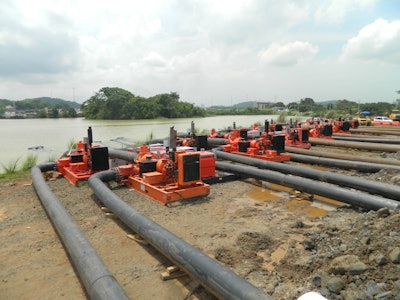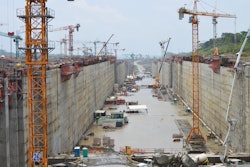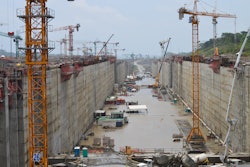
The Panama Canal Expansion Program, the largest development project of the canal since its original construction, will double the waterway’s capacity and have a direct impact on economies of scale and international maritime trade. As part of this ambitious project, Xylem, a leading global water technology company, was recently awarded a £4 million contract to provide rental dewatering equipment to solve a complex water transfer challenge in record time.
The Challenge
The Authority of the Panama Canal (ACP) began the Panama Canal Expansion Program in 2007, with an estimated cost of £3.4 billion. Scheduled for completion in the second quarter of 2016, the project will create a new traffic lane and build two new lock complexes, one on the Atlantic Ocean and the other on the Pacific, doubling the capacity of the canal and allowing for the passage of larger ‘post-Panamax’ ships, which are mainly used on longer routes.
In May 2015, Xylem supplied 64 Flygt mixers to prevent the formation of corrosive deposits on 16 rolling gates installed at the locks. In June 2015, when the ACP (Panama Canal Authority) needed to fill the third set of basin locks on the Pacific side of the canal with 1.7 billion gallons of water, as part of performance trials for the system prior to its commissioning, Xylem was once again ready to assist.
Mike Delzingaro, Vice President, Americas Sales, Xylem Dewatering, explains, “The scope of this project was immense. Xylem was tasked with pumping water from Lake Miraflores to the vast new locks of the Panama Canal to test their functionality – uphill, in large volumes and in record time. The tight timeline meant that we had to be ready to pump water 45 days after the initial contact from the Panama Canal Authority.”
The Solution
Xylem engineered a customized solution for the project, suggesting a reconfiguration of the original system design proposed, to save time and money for the customer. A tailored system was required which could handle pumping water up and over the wall of the new shipping channel. To meet the time challenge, Xylem chartered five Boeing 747 cargo planes to transport the rental pumps and equipment from the United States to Panama.
Dwight Evans, Senior Application Engineer, Xylem Dewatering, says, “Pump rental was exactly the right solution for this project. 15 Godwin CD 400M Dri-Prime pumps and 2.5 miles of high-density polyethylene (HDPE) pipe were deployed from the U.S. in June. Over a period of 22 days, these pumps transported up to 122 million gallons of water per day (MGD). In fact, the project consisted of pumping enough water to fill 90,000 average sized swimming pools.”
The Godwin Dri-Prime CD400M pump offers flow rates to 9,770 gallons per minute (GPM) and has the capability of handling solids up to 4.9 inches in diameter. The CD400M is able to automatically prime to 28 feet of suction lift. Solids handling, dry running and portability make the CD400M ideal for high volume dewatering, as was required for the Panama Canal project. Each of the Godwin pumps was equipped with a 16 inch pipe and a flow meter, ensuring that the required volume of water was pumped within the time frame.
Xylem has unique application expertise as the company manufactures and services all of its pumps, in addition to renting them. Xylem’s Godwin pumps are engineered and manufactured at its site in Quenington, Gloucestershire (since 1900). An ‘all-star’ team of the company’s highly-skilled engineers were on-the-ground to ensure the smooth installation and operation of the system at Panama. The tailored solution also included Xylem’s Godwin Field Smart Technology (FST) for real-time remote pump monitoring, ensuring water was flowing during critical pumping periods. This remote monitoring and control offered the customer peace of mind through a seamlessly controlled experience. All flow data was collected in the Godwin Advanced Control Panel (PLC); broadcast was accessible throughout the world through a web-server.
The Result
This was a unique and challenging task, both in terms of the dewatering requirement and the project timeline. Xylem leveraged its global experience at a local level to deliver a reliable, cost-effective and timely solution to solve this complex water challenge. With 20,000 pumps in its rental bank, Xylem was capable of delivering on this job – providing the expertise to re-engineer the system, deploy equipment to the site in record time and, ultimately, successfully pump 1.7 billion gallons of water in just 22 days.
Delzingaro adds, “Xylem has the world’s largest inventory of rental pumps and related equipment. This project demonstrates how capable we are of mobilizing incredible assets to a location that is difficult to reach, in a very short space of time, to solve a customer’s challenge. In combination with the local presence and engagement of our Panama-based team, we were able to custom tailor a turn-key operation that handled every aspect for the Panama Canal Authority - from transport, design and set-up, to pumping and monitoring; we provided a total rental solution.”
The third set of basin locks at the Panama Canal includes reuse basins that will save water and also improve the canal’s efficiency, using seven percent less water compared with the amount used by the existing locks. In addition, in each transit operation, 60 percent of the water will be recycled.
“Reliability, responsibility and our reputation as a key global rental player when it comes to dewatering solutions were key to securing this important rental contract. We were honored to work with the Authority of the Panama Canal and to be part of this project which expands one of the world’s most important transport routes,” concludes Delzingaro.



















